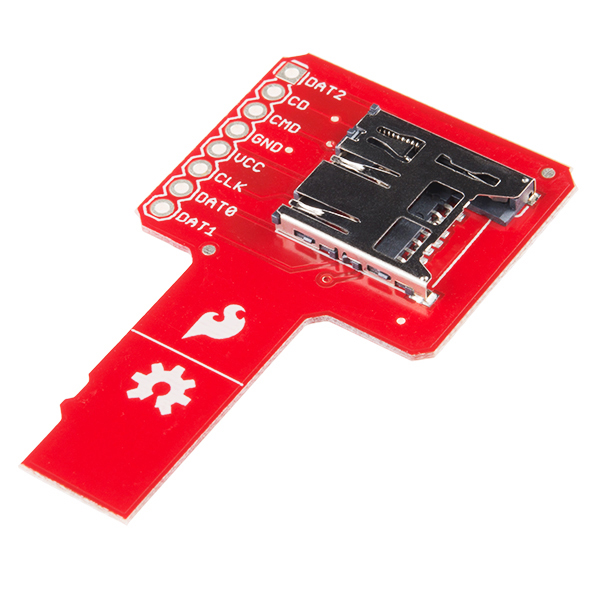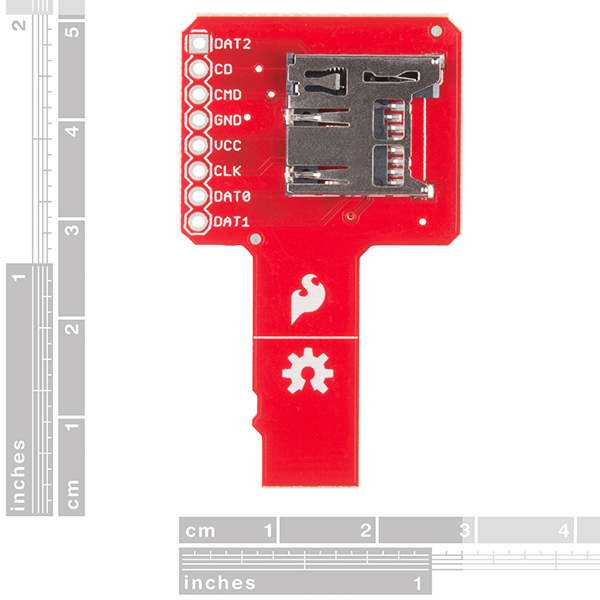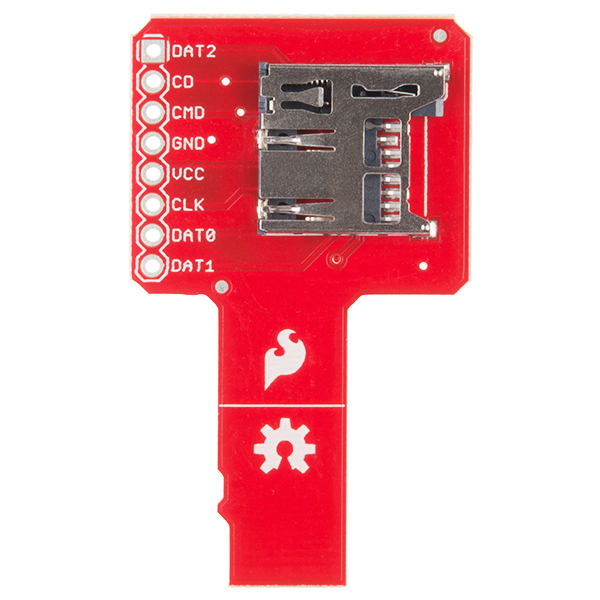SparkFun microSD Sniffer
This is a unique board recommended by a SparkFun customer. When playing with microSD, you sometimes need to view what the SPI traffic is doing, whether for hacking or debugging. The SparkFun microSD Sniffer allows you to hook up an external device, such as a logic analyzer or microcontroller, to view what signals are being passed back and forth. Insert one side into a regular uSD socket and a uSD card into the on-board socket, simple as that.
All necessary pins are broken out to an 8-pin 0.1" pitch header.
- Schematic
- Eagle Files
- GitHub (Design Files)
SparkFun microSD Sniffer Product Help and Resources
microSD Sniffer Hookup Guide
August 4, 2015
A basic introduction to working with the microSD Sniffer.
Core Skill: Soldering
This skill defines how difficult the soldering is on a particular product. It might be a couple simple solder joints, or require special reflow tools.
Skill Level: Noob - Some basic soldering is required, but it is limited to a just a few pins, basic through-hole soldering, and couple (if any) polarized components. A basic soldering iron is all you should need.
See all skill levels
Comments
Looking for answers to technical questions?
We welcome your comments and suggestions below. However, if you are looking for solutions to technical questions please see our Technical Assistance page.
Customer Reviews
3.5 out of 5
Based on 11 ratings:
5 of 5 found this helpful:
Good Idea Bad Manufacturing
I ordered two (2) TOL-09419 (Sparkfun microSD Sniffer). Both units do not work properly. The edge connector that connects to the host microSD has the following problem: 1. The connector does not engage and does not latch on to the host microSD properly. It disengages easily. The hook on the edge connector of the Sniffer is not shaped or sized properly to latch with the host microSD. 2. The edge connector itself is very thin, It would not make proper connections to the terminal connector of the host microSD. If it did make connections contact with the host because of problem #1, connection is very intermittent.
These problems have been verified by one of your engineers. The implementation could be improve greatly.
I rate your support service 5-stars. They acknowledge that it could not be fixed right away and refunded the full cost to my account.
1 of 1 found this helpful:
essential when bringing up an SD socket on newly designed h/w
Worked well. Product gave me what I needed to place logic analyzer channels on every data signal. Plus it provided a ground pin I used to ground the logic analyzer's channels.
Complaints: 1) it didn't come with a header. Not a big deal, but to me it seems incomplete without the header. 2) it didn't latch into my SD card socket as well as a SD card seems to. I found myself manually applying pressure to the card, pressing it inward toward the card socket (holding its contacts securely against the SD card socket's contact) so as to be able to have repeatable results.
That said, I would purchase this sniffer again.
2 of 2 found this helpful:
Works good. Needs a little redesign.
Electrically, it works great, no problems. Mechanically, it could be better--
1- It doesn't latch into the card slot. The milling to make the "hook" part of the pcb is not very good. I have to wrap some tape around everything to keep it from popping out all the time.
2- It's too wide for my application. The usb port for my device is right next to the card slot. I had to cut the molding off the cable and shave the pcb a little so that I could plug both in at the same time.
1 of 1 found this helpful:
Just what I needed - too bad it doesn't work
The pads don't align in the socket and it doesn't latch properly.
Sorry to hear you weren't satisfied. I have arranged a refund for you. Have a nice day!
This was just what I needed!
Worked out perfectly for my generic Allwinner based tablet. I was experimenting with a custom recovery and got to the point where I needed more debug information. I ordered this breakout board, soldered on a header, and connected it up to my SparkFun USB TTY serial device. It was amazing and I was so glad when it worked right away. I was able to get the tablet into fastboot and fixed my problem.
Garbage, poor quality control
This product meant to be a printed circuit board, cut into the shape of a micro SD card. The problem with the one shipped to me is that it isn't in the shape of a micro SD card, and where it counts it's not even close.
This circuit board is sloppily cut. Lines that must be straight are curved. The outer corners that are supposed to be radiused are sharp. There are some inner corners in the notch behind the tab on the SD card. The shape of those is essential to micro SD cards fitting in their sockets. Where real micro SD cards have straight lines, crisp corners and very tight tolerances, this product has just a wide, curved edge and sloppy quality.
I'm guessing that this product was probably designed with good intentions, but was manufactured with too large a router bit, and possibly touched up by hand.
This product also seems like it's thicker than real micro SD cards, but that's probably not a deal-breaker and is harder to fix.
It doesn't work at all in my Raspberry Pi 2 Model B V1.1.
Very practical, the right size for use and good looking
All good
Exactly as described.
Great product
Good quality, works as described
Board thickness doesn't match SD card thickness
You must shim liberally to make it work.
Nice simple tool
Makes tinkering with microSD easy.






The latching or physical characteristics of the board are terrible (as reported in numerous buyer reviews). It simply won't stay in place within most SD slots. I wish Sparkfun listened to the feedback more and tried to remedy this significant flaw.
would it be legal to reverse engineer the SD bus (the high speed mode, not the sluggish SPI mode) and publish the specifications?
Reverse engineering is usually legal. In other words go for it.
This thing is cool, but what I'd REALLY like is some kind of adapter that lets me swing the SD card between my PC and a Beagleboard. Kinda like a KVM switch.
So I can switch SD cards without touching anything. Like, for automated testing.
Wonder also if trick phone thinking a Nordic rf is storage and send a text to it to send?
Wondering if it would be a experiment to network two smart phones or three ...., ? Or ISP from phone/tablet to arduino spi?
Can I use these with arduino fio?
This is almost exactly what i'm looking for, you see, i'm wanting to make a micro sd card to usb adapter, i was thinking the other day that they make usb sticks that you can put a sd card in, so why not go the opposite way and use high capacity usb drives on a phone. Temporarily of course, you don't want to stick the phone in your pocket with it plugged in, it would break, but for stuff like music, pictures, movies all stored on a usb stick, plug in the adapter and use usb drives for your phone. Now to just figure out how to reverse engineer it.
Hi, This looks like a good board. I'm trying to make a modified version of it. Do you know where can one print a PCB of this thickness? (0.75mm).
I am looking for something not very costly that could do a 2-layer 2x1 board of the required 0.75mm thickness.
Thanks.
Hi! I hope that you can produce something. Unfortunately boards of this thickness aren't very common. The chance of being able to find small batch services for this thin board may be harder than normal, or they may have a larger minimum order. You might communicate with OSH Park to see if they can run something. If you find something, please reply back here so that we can all know how it worked out!
Should have used a gold finish for boards like this with bare contacts - silver tarnishes too easily.
This worked GREAT not just for sniffing but also acting without an SD card as a SD card emulator/man-in-the-middle for nikon hacking and just as a pure SD card reader i can reach for when breadbording!
also YES it works with a microSD to full SD converter
What is the green circuit board thing? Thanks.
That green board is actually an old version of our Logomatic board.
would this show the communication involved in SD DRM operations? e.g. on symbian and windows phones, how they can encrypt the device so it can't be read on a PC. I've got an SD card from my windows phone that's currently bricked because no device other than WP7/symbian is capable of reformatting it, and i really don't want to have to buy a symbian phone just to get my SD card working again =(
Have you tried using a program like MiniTool Partition Wizard? It's free and I've used it to reformat cards my PC couldn't reformat correctly.
A little late but for future knowledge, this would show any and all communication going to and from the microSD card.
Would there be any issue using this as a makeshift microSD breakout?
It looks like it should work as a uSC breakout just fine.
This is sparkfun's microSD breakout. If that helps.
Is there a microSd to SD adapter, I have to use EyeFi which is in SD form on a device that has only microsd.
I've been looking to do the same thing - a microSD male to SD female adapter. The only solution I've been able to find is to buy this and the Sparkfun SD breakout board and run the wires/headers from the appropriate pins.
This is actually a better solution to me (except for the cost) because I keep this particular project in a shielded box, and the EyeFi has trouble transmitting through it. Using wires between the two boards allows me to rout the wifi adapter wherever.
If you already have an SD port, this is probably the cheapest retail WiFi setup for an Arduino (except for adding an Xbee to a Fio or something similar). It's pretty easy to use too, since the SD library is pretty well made. Even better, I get my Wifi over i2c since my Sd port is on my SmartGPU ( http://vizictechnologies.com/#/smart-gpu/4554296549 ).
do you mean SD to microSD?
Can you please clarify the following topic:
I put the microSD sniffer (from sparkfun) into the microSD
breakout board (also from sparkfun).
It looks like pin "CS" from microsd breakout board
goes to (measurement) pin "CD" on microSD sniffer
and obviously futher to pin "CS" of microsd card
put into microsd sniffer (otherwise i think it would not work).
Could it be that white text "CD" on microSD sniffer should
be white text "CS" ?
Perhaps also schematic is wrong:
(http://www.sparkfun.com/datasheets/Tools/microsniffer-v14.pdf)
"CD/DAT3" shall be "CS/DAT3" ?
I am no SD/uSD card expert, please clarify.
Any chance to get the eagle file for this board? I've been looking for the physical layout of a microSD.
Yep. Should be posted now. Sorry it took so long!
A lot of the SD stuff is already published.
However this might be easier to use to ISP program the OpenLog (or other boards with SD interfaces connected to the SPI)